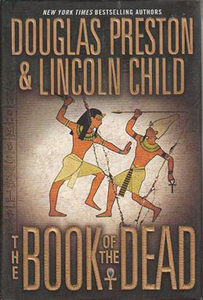Douglas Preston and Lincoln Child wrap up the Diogenes Trilogy in epic, sprawling and satisfying fashion in “The Book of the Dead” (2006). By the time you’re done with the 597-page tome, you may have forgotten what happened at the beginning.
It’s almost like a series of short stories, taking a reader through Egyptian history to an ingenious prison break to a scientific exploration of the adverse effects of a sound-and-light show on the human brain.
Brotherly hate
At “Book of the Dead’s” core, though, is the rivalry between the Pendergast brothers. Here, we finally learn of the incident from their childhoods – remembered by Diogenes, blocked out by Aloysius – that makes Diogenes hate his older brother.
Aloysius has to go into his mind palace (introduced in “Still Life with Crows”) to retrieve the buried memory, initially resisting the prodding of Eli Glinn (introduced in “The Ice Limit”) to do so. If Pendergast is scared of something, we know it’s scary; as such, P&C are able to put a creepy vibe into something that’s ridiculous on the surface: a 19th century-vintage carnival show.
With “Book of the Dead,” the authors are forced to bring Diogenes and the even more mysterious Constance Greene — Pendergast’s ward who never leaves the Riverside Drive mansion – to the fore.
In “Dance of Death,” we learned in a fun surprise that Diogenes has an alternate identity as New York Museum of Natural History professor Hugo Menzies.
But they only let readers in on the secret, not the characters. As such, it’s a blast in this book to see Menzies through our knowing lens, playing along in board meetings, dodging the probings of Smithback, and poisoning poor hospitalized Margo (who again is a glutton for punishment, but at least she’s still alive).
Constance stays mysterious
P&C aren’t ready to totally lift the veil from Constance, though. She is the woman scorned here; after Diogenes seduces and beds her, he tries to drive her to suicide, seeing her as a pawn in his game against his brother.
It’s a shame on one level, because they could’ve made an interesting couple as two lost souls who don’t fit in the real world – although that might be me falling under Diogenes’ phony sway, too.
When Constance pursues Diogenes around the globe for payback, we never see her perspective. Rather, we see Diogenes off-balance for the first time, and also Aloysius following both of them.
When Pendergast investigates pages in a library atlas and finds threads from Constance’s clothes, thus learning where she is headed, I imagine even P&C were laughing at the absurd level of investigative talent on display.
Even after an epic showdown on the lip of a volcano on a remote Mediterranean island – something that especially called to mind 2005’s “Star Wars: Revenge of the Sith” upon publication – Constance remains a cipher. How could someone who led a sheltered life for a century (while not physically aging beyond 21) outsmart an evil genius?

I admit I went with it, and it probably helps that we don’t get Constance’s point of view. If Pendergast – who is encouraged by girlfriend Viola to treat Constance like a daughter — is baffled, we’re allowed to be baffled along with him.
More nights at the museum
“Book of the Dead” again uses the New York Museum of Natural History as a horror setting, and nope, I’m still not tired of it, even after “Relic,” “Cabinet of Curiosities” and “Dance of Death.”
I had always assumed new exhibits are installed in a rotating main exhibit hall, but the Tomb of Senef exhibit has been walled up in the basement for the better part of a century. Museum politics call for Nora and her team to do a rush-job of dusting it off and readying it for the public.
While there’s never any threat that Mbwun will come back, or much of a chance that P&C can top their original monster, they still get mileage out of the vibe. Here, suggestions of a mummy curse dovetail nicely with a being that stalks the halls with a “draaag-thump” sound, this novel’s equivalent of the goatish odor that signified Mbwun.
Up in the attic
The museum’s attics make an excellent place for a pursuit sequence; the word is pluralized because the attics of several buildings are connected, but they aren’t all at the same elevation, so there are small stairways linking them.
Additionally, they have a setup – probably grandfathered in to the current fire code – wherein rooms are accessible only by moving through other rooms, an architectural quirk Child would revisit in “The Forgotten Room.”
“Book of the Dead” is a notch down from the flawless “Dance of Death,” because it does so much that it leaves you reeling. If you’re really into a certain topic – say, Egyptian history – you might wish the whole novel was about that topic, rather than merely a segment.
Although everything is tied up plausibly – even Pendergast’s pardon for his prison escape – there’s no denying that P&C aren’t ready to play all their cards yet, especially in regard to Constance.


